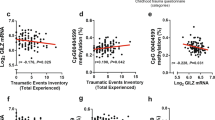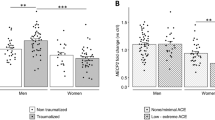Abstract
Pituitary adenylate cyclase-activating polypeptide (PACAP) is known to broadly regulate the cellular stress response. In contrast, it is unclear if the PACAP–PAC1 receptor pathway has a role in human psychological stress responses, such as post-traumatic stress disorder (PTSD). Here we find, in heavily traumatized subjects, a sex-specific association of PACAP blood levels with fear physiology, PTSD diagnosis and symptoms in females. We examined 44 single nucleotide polymorphisms (SNPs) spanning the PACAP (encoded by ADCYAP1) and PAC1 (encoded by ADCYAP1R1) genes, demonstrating a sex-specific association with PTSD. A single SNP in a putative oestrogen response element within ADCYAP1R1, rs2267735, predicts PTSD diagnosis and symptoms in females only. This SNP also associates with fear discrimination and with ADCYAP1R1 messenger RNA expression in human brain. Methylation of ADCYAP1R1 in peripheral blood is also associated with PTSD. Complementing these human data, ADCYAP1R1 mRNA is induced with fear conditioning or oestrogen replacement in rodent models. These data suggest that perturbations in the PACAP–PAC1 pathway are involved in abnormal stress responses underlying PTSD. These sex-specific effects may occur via oestrogen regulation of ADCYAP1R1. PACAP levels and ADCYAP1R1 SNPs may serve as useful biomarkers to further our mechanistic understanding of PTSD.
This is a preview of subscription content, access via your institution
Access options
Subscribe to this journal
Receive 51 print issues and online access
$199.00 per year
only $3.90 per issue
Buy this article
- Purchase on Springer Link
- Instant access to full article PDF
Prices may be subject to local taxes which are calculated during checkout





Similar content being viewed by others
References
Miyata, A. et al. Isolation of a novel 38 residue-hypothalamic polypeptide which stimulates adenylate cyclase in pituitary cells. Biochem. Biophys. Res. Commun. 164, 567–574 (1989)
Ghzili, H. et al. Role of PACAP in the physiology and pathology of the sympathoadrenal system. Front. Neuroendocrinol. 29, 128–141 (2008)
Hashimoto, H., Shintani, N. & Baba, A. New insights into the central PACAPergic system from the phenotypes in PACAP- and PACAP receptor-knockout mice. Ann. NY Acad. Sci. 1070, 75–89 (2006)
Spengler, D. et al. Differential signal transduction by five splice variants of the PACAP receptor. Nature 365, 170–175 (1993)
Watanabe, J. et al. Localization, characterization and function of pituitary adenylate cyclase-activating polypeptide during brain development. Peptides 28, 1713–1719 (2007)
Zhong, Y. Mediation of PACAP-like neuropeptide transmission by coactivation of Ras/Raf and cAMP signal transduction pathways in Drosophila. Nature 375, 588–592 (1995)
Hammack, S. E. et al. Chronic stress increases pituitary adenylate cyclase-activating peptide (PACAP) and brain-derived neurotrophic factor (BDNF) mRNA expression in the bed nucleus of the stria terminalis (BNST): roles for PACAP in anxiety-like behavior. Psychoneuroendocrinology 34, 833–843 (2009)
Vaudry, D. et al. Pituitary adenylate cyclase-activating polypeptide and its receptors: 20 years after the discovery. Pharmacol. Rev. 61, 283–357 (2009)
Breslau, N. The epidemiology of posttraumatic stress disorder: what is the extent of the problem? J. Clin. Psychiatry 62 (Suppl 17). 16–22 (2001)
Hoge, C. W., Auchterlonie, J. L. & Milliken, C. S. Mental health problems, use of mental health services, and attrition from military service after returning from deployment to Iraq or Afghanistan. J. Am. Med. Assoc. 295, 1023–1032 (2006)
Binder, E. B. et al. Association of FKBP5 polymorphisms and childhood abuse with risk of posttraumatic stress disorder symptoms in adults. J. Am. Med. Assoc. 299, 1291–1305 (2008)
Bradley, R. G. et al. Influence of child abuse on adult depression: moderation by the corticotropin-releasing hormone receptor gene. Arch. Gen. Psychiatry 65, 190–200 (2008)
Gillespie, C. F., Phifer, J., Bradley, B. & Ressler, K. J. Risk and resilience: genetic and environmental influences on development of the stress response. Depress. Anxiety 26, 984–992 (2009)
Foa, E. B. & Tolin, D. F. Comparison of the PTSD symptom scale-interview version and the clinician-administered PTSD scale. J. Trauma. Stress 13, 181–191 (2000)
Bangasser, D. A. et al. Sex differences in corticotropin-releasing factor receptor signaling and trafficking: potential role in female vulnerability to stress-related psychopathology. Mol. Psychiatry 15, 896–904 (2010)
McEwen, B. S. Steroid hormones: effect on brain development and function. Horm. Res. 37 (Suppl 3). 1–10 (1992)
Shansky, R. M. et al. Estrogen promotes stress sensitivity in a prefrontal cortex-amygdala pathway. Cereb. Cortex 20, 2560–2567 (2010)
Jovanovic, T. et al. Impaired fear inhibition is a biomarker of PTSD but not depression. Depress. Anxiety 27, 244–251 (2010)
Jovanovic, T. & Ressler, K. J. How the neurocircuitry and genetics of fear inhibition may inform our understanding of PTSD. Am. J. Psychiatry 167, 648–662 (2010)
Rauch, S. L., Shin, L. M. & Phelps, E. A. Neurocircuitry models of posttraumatic stress disorder and extinction: human neuroimaging research—past, present, and future. Biol. Psychiatry 60, 376–382 (2006)
Shin, L. M. & Liberzon, I. The neurocircuitry of fear, stress, and anxiety disorders. Neuropsychopharmacology 35, 169–191 (2010)
Yehuda, R. & LeDoux, J. Response variation following trauma: a translational neuroscience approach to understanding PTSD. Neuron 56, 19–32 (2007)
Gillespie, C. F. et al. Trauma exposure and stress-related disorders in inner city primary care patients. Gen. Hosp. Psychiatry 31, 505–514 (2009)
Aenlle, K. K., Kumar, A., Cui, L., Jackson, T. C. & Foster, T. C. Estrogen effects on cognition and hippocampal transcription in middle-aged mice. Neurobiol. Aging 30, 932–945 (2009)
Corneveaux, J. J. et al. Association of CR1, CLU and PICALM with Alzheimer's disease in a cohort of clinically characterized and neuropathologically verified individuals. Hum. Mol. Genet. 19, 3295–3301 (2010)
Grillon, C., Morgan, C. A., III, Davis, M. & Southwick, S. M. Effect of darkness on acoustic startle in Vietnam veterans with PTSD. Am. J. Psychiatry 155, 812–817 (1998)
Walker, D. L. & Davis, M. Double dissociation between the involvement of the bed nucleus of the stria terminalis and the central nucleus of the amygdala in startle increases produced by conditioned versus unconditioned fear. J. Neurosci. 17, 9375–9383 (1997)
Walker, D. L. & Davis, M. Light-enhanced startle: further pharmacological and behavioral characterization. Psychopharmacology (Berl.) 159, 304–310 (2002)
McMahon, F. J. et al. Meta-analysis of genome-wide association data identifies a risk locus for major mood disorders on 3p21.1. Nature Genet. 42, 128–131 (2010)
Myers, A. J. et al. A survey of genetic human cortical gene expression. Nature Genet. 39, 1494–1499 (2007)
Botia, B. et al. Neurotrophic effects of PACAP in the cerebellar cortex. Peptides 28, 1746–1752 (2007)
Brenneman, D. E. Neuroprotection: a comparative view of vasoactive intestinal peptide and pituitary adenylate cyclase-activating polypeptide. Peptides 28, 1720–1726 (2007)
Dejda, A. et al. Inhibitory effect of PACAP on caspase activity in neuronal apoptosis: a better understanding towards therapeutic applications in neurodegenerative diseases. J. Mol. Neurosci. 36, 26–37 (2008)
Hamelink, C. et al. Pituitary adenylate cyclase-activating polypeptide is a sympathoadrenal neurotransmitter involved in catecholamine regulation and glucohomeostasis. Proc. Natl Acad. Sci. USA 99, 461–466 (2002)
Davis, M. The role of the amygdala in fear and anxiety. Annu. Rev. Neurosci. 15, 353–375 (1992)
Ehrlich, I. et al. Amygdala inhibitory circuits and the control of fear memory. Neuron 62, 757–771 (2009)
Fanselow, M. S. & LeDoux, J. E. Why we think plasticity underlying Pavlovian fear conditioning occurs in the basolateral amygdala. Neuron 23, 229–232 (1999)
LeDoux, J. E. Emotional memory: in search of systems and synapses. Ann. NY Acad. Sci. 702, 149–157 (1993)
Maren, S. & Quirk, G. J. Neuronal signalling of fear memory. Nature Rev. Neurosci. 5, 844–852 (2004)
Pape, H. C. & Pare, D. Plastic synaptic networks of the amygdala for the acquisition, expression, and extinction of conditioned fear. Physiol. Rev. 90, 419–463 (2010)
Girard, B. A. et al. Noncompensation in peptide/receptor gene expression and distinct behavioral phenotypes in VIP- and PACAP-deficient mice. J. Neurochem. 99, 499–513 (2006)
Acknowledgements
This work was primarily supported by NIH grant MH071537 (K.J.R.), as well as DA019624 (K.J.R.) and HD27468 (V.M.). Support was also received from Emory and Grady Memorial Hospital General Clinical Research Center, NIH National Centers for Research Resources (M01RR00039 and P20RR16435), the American Foundation for Suicide Prevention (B.B.) and the Burroughs Wellcome Fund (K.J.R.). RNA samples were run using the Oncogenomics Core Facility at University of Miami. A.J.M. is supported by The National Institute on Aging (AG034504). We thank J.F. Cubells, Y. Tang and K. Conneely for discussions. We thank the Grady Trauma Project, including C.F. Gillespie, A. Schwartz, A. Wingo, D.A. Gutman and T. Weiss for medical support; A. Graham, A. Brown, J. Phifer, D. Crain, A. Kamkwalala, J. Poole, D. Cross, N. Fani and A. Smith for clinical research support; and K. Schutz, E. Reiser and C. Fitzgerald for molecular/genetics technical support. Methylation chip assays were performed by the Emory University Biomarkers Service Center.
Author information
Authors and Affiliations
Contributions
K.J.R. designed the initial experiments and wrote the initial version of the paper. K.J.R., B.B. and V.M. organized collaborations, obtained funding, supervised data collection and analyses, and revised the paper. K.B.M., K.K. and E.B.B. performed the genetics experiments and analyses on the primary, replication and GAIN cohorts, and revised the paper. T.J. and S.D.N. performed and supervised the human physiology studies and revised the paper. V.K. and A.K.S. performed and supervised the methylation studies and revised the paper. A.M. and K.J.R. performed and supervised the rodent fear conditioning and related RT–PCR analysis. D.T., S.E.H. and V.M. performed and supervised the oestrogen replacement studies and related RT–PCR analyses, and assisted with paper revisions. A.J.M., M.R. and A.E. performed and supervised the human mRNA expression analyses and the Alzheimer’s disease gene association studies. K.M.B. and V.M. performed and supervised the PACAP38 radioimmunoassays and related data analyses.
Corresponding author
Ethics declarations
Competing interests
The authors declare no competing financial interests.
Supplementary information
Supplementary Information
The file contains Supplementary Materials and Methods, Supplementary References, Supplementary Tables 1-4 and Supplementary Figures 1-3 with legends. (PDF 1404 kb)
Rights and permissions
About this article
Cite this article
Ressler, K., Mercer, K., Bradley, B. et al. Post-traumatic stress disorder is associated with PACAP and the PAC1 receptor. Nature 470, 492–497 (2011). https://doi.org/10.1038/nature09856
Received:
Accepted:
Published:
Issue Date:
DOI: https://doi.org/10.1038/nature09856
This article is cited by
-
Exosome-sheathed ROS-responsive nanogel to improve targeted therapy in perimenopausal depression
Journal of Nanobiotechnology (2023)
-
Circulating PACAP levels are associated with increased amygdala-default mode network resting-state connectivity in posttraumatic stress disorder
Neuropsychopharmacology (2023)
-
The role of estrogen receptor manipulation during traumatic stress on changes in emotional memory induced by traumatic stress
Psychopharmacology (2023)
-
PACAP-PAC1R modulates fear extinction via the ventromedial hypothalamus
Nature Communications (2022)
-
Oral microbiota signatures in post-traumatic stress disorder (PTSD) veterans
Molecular Psychiatry (2022)
Comments
By submitting a comment you agree to abide by our Terms and Community Guidelines. If you find something abusive or that does not comply with our terms or guidelines please flag it as inappropriate.



